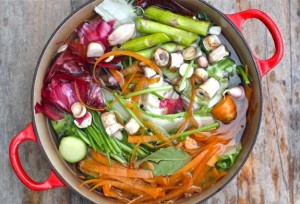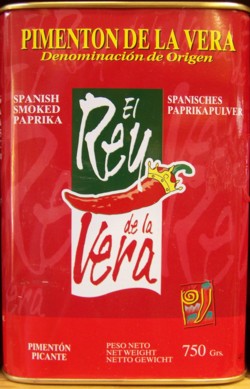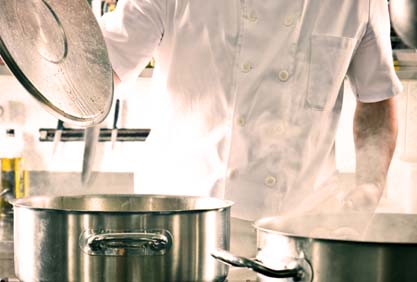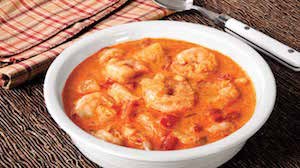By Dave DeWitt
Soups are the elegant side of a chef’s kitchen. In professional cooking, tradition holds that the head chef always makes the soup. In fact, if you catch the chef eating something in his kitchen, chances are it will be a soup. Why do chefs love soups? Because it gives them a chance to recycle some of the byproducts of the main dishes, as well as take advantage of seasonal ingredients. Chefs believe that soups are the everyday practice of the art of balancing flavors, and the same concepts used to make great sauces will work to make great soups. Soup-making is an elegant art and an understated way to show off one’s culinary expertise.
Chefs also love soups because they are make-ahead meals that can be held for a long time before serving. A soup to open a meal signals that what follows will be an elegant feast. Yet soups are also basic comfort foods, and can become a full meal when served with the right accompaniments. Also, soups are a great way to use up supermarket loss leaders or special sales. For example, salmon does not freeze particularly well, but salmon stock does.
Making Good Stocks
It is an axiom of soup making that a great soup starts with a great stock. So, if a cook is going to go to all the trouble of making a soup from scratch, first make a good stock. It doesn’t take very much time to make good stocks, and in many cases they are the keys to the vibrant flavors of soups. Stocks store well and freeze well, so they are worth the effort it takes to make them.
To make a good stock, use real ingredients—do not use bouillon cubes or powders, or canned stocks. Use fresh garlic (not granulated), and fresh celery leaves. Always use fresh herbs unless they are unavailable; if using dry herbs, double the amount in the recipe.
 Chefs believe that the trash can or garbage disposal is the enemy of a good stock, so try to recycle as much as you can in the kitchen. In professional chef competitions, the trash is weighed and chefs have points deducted for disposing of too much. We keep several plastic bags in the freezer for trimmed and leftover ingredients that can be used in stocks. We save such things as the end pieces of onions and carrots, the trimmings from celery, parsley stems, mushroom stems, and shrimp skins (for seafood base). Always save bones for meat stocks, and fish parts, bones, and trimmings for a seafood stock. Sometimes seafood butchers can be talked out of their trimmings, such as fish heads, shrimp peels, fins, bones, and you can turn them into great stocks.
Chefs believe that the trash can or garbage disposal is the enemy of a good stock, so try to recycle as much as you can in the kitchen. In professional chef competitions, the trash is weighed and chefs have points deducted for disposing of too much. We keep several plastic bags in the freezer for trimmed and leftover ingredients that can be used in stocks. We save such things as the end pieces of onions and carrots, the trimmings from celery, parsley stems, mushroom stems, and shrimp skins (for seafood base). Always save bones for meat stocks, and fish parts, bones, and trimmings for a seafood stock. Sometimes seafood butchers can be talked out of their trimmings, such as fish heads, shrimp peels, fins, bones, and you can turn them into great stocks.
Stocks should be concentrated, so be sure to boil them down. This is classic French reduction technique and the cook can always add the water back to the concentrated stock. Soups will taste better using concentrated stocks, and they take up less room in the freezer.
After the stock has been reduced, cool in it the freezer; any fat fat will rise and congeal and it can be removed with a spoon. Instead of using bouillon cubes, freeze the stocks in ice cube trays and remove the cubes to zip bags. Then you can have small amounts of stock when you need them.
Cream of Jalapeño Soup with Chicken
Here’s an innocent-looking soup that is hotter than it appears. The combination of chicken and chiles occurs often in Southwestern cuisines but the use of jalapeños is more prevalent in Texas.
4 jalapeños, stems and seeds removed, chopped
1 3-pound chicken, cut in pieces
1 large onion, chopped
1 stalk of celery, chopped
2 carrots, peeled and diced
1 clove garlic, chopped
1 teaspoon ground cumin
1 quart water
2 cups half and half
1 or 2 jalapeños, stems and seeds removed, finely chopped for garnish
Combine the jalapeños, chicken, onion, celery, carrots, garlic, cumin, and water. Bring to a boil, reduce the heat, cover and simmer until the chicken starts to fall off the bones. Remove the chicken and bones and reserve the stock. Remove the skin and fat from the chicken and shred the meat.
Puree the stock and strain the mixture so that it is smooth.
Pour 3 cups of the stock into a large saucepan, add the half and half, and heat through.
Add the chicken and heat through. Garnish with the finely chopped jalapeños and serve.
Yield: 6 servings
Heat Scale: Hot
Acorn Squash and Corn Stew with Chipotle
There’s a lot of rich, smoky flavors here for such a simple recipe. The chipotle used can be either rehydrated dried pods that are then chopped fine, or the canned chipotles in adobo. To prepare the acorn squash, cut them in half, remove the seeds and add 1 teaspoon bacon grease or butter to each half and bake the squash at 350 degrees for 1 1/4 hours.
1 tablespoon peanut oil
1 medium onion, chopped
1 tablespoon minced onion
4 cups tomato sauce
2 tablespoons finely chopped chipotle chile
1 tablespoon salt
2 cups corn kernels cut from cobs
3 cups baked, soft acorn squash (about 2 medium squashes)
½ cup terriyaki sauce
3 cups water
3 cups chicken stock
1 teaspoon ground cinnamon
½ teaspoon bay leaf
½ teaspoon vanilla
1 cup freshly squeezed orange juice
1 tablespoon sugar
1 tablespoon raw honey
1½ tablespoons freshly squeezed lime juice
Garlic croutons for garnish
Heat the oil in a pot and add the onion and garlic. Saute until the onion is soft, about 5 minutes, then add the tomato sauce, chipotle chiles, salt, and corn kernels and cook, uncovered, over medium heat for 15 minutes.
Add the squash, terriyaki sauce, water, chicken stock, cinnamon, bay leaf, and vanilla and cook, uncovered, for 20 minutes.
Combine the orange juice, sugar, honey, and lime juice in a bowl and add it to the stew. Heat for 5 minutes.
Serve sprinkled with garlic croutons.
Yield: 8 servings
Heat Scale: Medium
Veracruz-Style Shrimp Chowder
In Veracruz, Mexico, this dish is known as Chilpachole Veracruzano. The use of dried shrimp in here intensifies the flavor. Dried shrimp and epazote are available in Latin and Asian markets. There is no substitute for epazote, with its unique, pungent flavor. Serve the shrimp stew in bowls or over cooked rice and garnish with lemon or lime slices.
8 cloves garlic, unpeeled
2 chipotle chiles, seeds and stems removed
2 ancho chiles, seeds and stems removed
1 onion, cut into eighths
3 tomatoes, peeled and cut into quarters
3 tablespoons oil
3 cups water or Traditional European Fish Stock
8 dried shrimp
1/4 cup epazote
2 pounds fresh shrimp, shelled and deveined
Wrap the unpeeled cloves of garlic in aluminum foil and roast them in a 400 degree F oven for 30 minutes. When they are cool enough to handle, squeeze the garlic out of the skin into a blender.
Using a dry skillet, lightly roast the chiles for 2 minutes, taking care not to burn them. Add the chiles to the blender along with the onion and the tomatoes and puree the mixture.
Heat the oil in a medium skillet, pour in the pureed mixture, and cook it over a medium low heat for 1 minute. Then, add the water, dried shrimp, and the epazote and simmer for 3 minutes.
Add the fresh shrimp and simmer the mixture for an additional 5 minutes, or until the shrimp are cooked. Add more water if the mixture starts to get too thick. Serve immediately.
Yield: 4 servings
Heat Scale: Medium
Southwest Salsa Soup with Lime Cream
Using a commercial salsa as a base for this soup makes it quick and easy to prepare, as well as allowing you to choose your spice level, from mild to wild. The heat of the salsa will intensify, so we don’t recommend you use a habanero-based salsa or any other that is too hot. This simple soup can also be made more hearty with the addition of cooked pinto or black beans, chicken or turkey, or even whole-kernel corn. Add these to the soup after it has been pureed. For the taste of green chile and chicken enchiladas in soup form, just use green chile salsa and add chicken.
2 to 3 teaspoons vegetable oil
1 cup chopped onion
2 teaspoons chopped garlic
1 1/2 cups tomato-based commercial salsa
3 cups chicken broth, preferably homemade
2 corn tortillas, torn into pieces
1/4 teaspoon ground cumin
Salt and freshly ground black pepper to taste
1/4 cup chopped, fresh cilantro
Lime Cream for garnish (recipe below)
Heat a heavy saucepan or stockpot over medium-high heat, add the oil, and when hot, add the onions and sauté until they are soft. Add the garlic and continue to sauté for an additional minute.
Stir in the salsa, broth, tortillas, cumin, and salt and pepper and bring to a boil. Reduce the heat and simmer until the tortillas are soft. Remove from the heat and cool slightly.
Put the mixture into a blender or food processor and puree until smooth. Taste and adjust the seasonings and stir in the cilantro.
To serve, ladle the soup into individual bowls and garnish with a dollop of lime cream.
Yield: 4 to 6 servings
Heat scale: Mild to Hot
Lime Cream
This cream can be prepared ahead of time and refrigerated until you are ready to serve.
2 tablespoons lime juice, preferably fresh
1/2 cup sour cream
1/4 cup heavy cream
Combine all the ingredients in a bowl and stir to mix. Refrigerate any cream that is not used.
Yield: 3/4 cup
Pimentón Garlic Soup

The classic garlic soup of Madrid is transformed into a smoky-hot masterpiece with the addition of pimentón, a powder made from oak-smoked chiles. In Spain, pimiento is a generic term for chiles; the one used in pimentón is either a long chile that produces a sweet powder, a round cascabel-like chile that is the hot variety, or a third one that is used for agridulce, or bittersweet pimentón. The trick to a good garlic soup is to cook the garlic very slowly so that it’s soft and creamy, not browned. The amount of garlic can be adjusted to suit your tastes. If you can’t locate pimentón, mix equal portions of red New Mexican chile powder and chipotle powder.
2 tablespoons extra-virgin olive oil, preferably Spanish
2 to 3 slices bacon
6 to 8 cloves garlic, thinly sliced
1 1/2 tablespoons hot pimentón (available online and from gourmet shops)
1/4 teaspoon ground cumin
6 cups chicken broth
10 baguette bread slices, crusts removed, sliced 1/2 inch thick and toasted
Salt to taste
4 eggs
Chopped fresh flat-leaf parsley, 4 lime wedges for garnish
Heat a saucepan or stockpot over medium heat, add the oil and bacon, and when hot, add the garlic, reduce the heat, and slowly sauté until the garlic is soft, being careful that it doesn’t brown.
Add the pimentón and cumin and stir to mix. Whisk in the broth, bring to a boil, reduce the heat, add the bread, and simmer for 5 minutes. Taste and season with salt.
Carefully break each egg into the soup so that it rests on top of the soup. Cover the pot and simmer until the whites of the eggs are set and yolks are soft, about 4 minutes.
To serve, ladle the soup and an egg into individual bowls, being careful that the yolks don’t break. Garnish with the chopped parsley and serve with a lime wedge for sprinkling over the soup.
Yield: 4 servings
Heat scale: Medium







